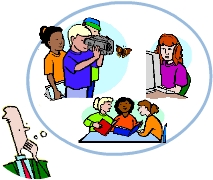Instructional Strategies

Description: Instructional Strategy Image
Image copyright: http://tile.missouri.edu/teacher/ms.html
1. Structured Controvery
http://bblearn.fontbonne.edu/webapps/portal/frameset.jsp?tab_group=courses&url=%2Fwebapps%2Fblackboard%2Fcontent%2FcontentWrapper.jsp%3Fcontent_id%3D_900894_1%26displayName%3DLinked%2BFile%26course_id%3D_21821_1%26navItem%3Dcontent%26attachment%3Dtrue%26href%3Dhttp%253A%252F%252Fglossary.plasmalink.com%252Fglossary.html
In this instructional strategy, one would select a specific problem, and with limited information the students would construct what they feel is the underlying issue.
Lesson Opportunity: Students will discuss alternative reasons for the Civil War. They will have to reflect on prior conversations and their research of the subject to construct alternate reasons for it. This strategy implores students to learn more about the Civil War and have an opinion about it. It also requires them to see things from different perspectives.
2. Carousel Brainstorming
http://its.gcsnc.com/act/strategies/carousel_brainstorming.htm
In this instructional strategy students are gathered in small groups, and given a number or color assigned to the group. Each group is responsible for an answer to the questions assigned to them. Since this is group work, each student is asked to give their opinion on a particular question and the answers are recorded as a whole group. After questions are answered students will move around the room to different groups who will provide them with alternative answers to questions.
Lesson Opportunity: Students are essentially the experts in this strategy. I am currently working on a class, and this would be a good opportunity for online students to share with me some ideas of what they think their first online experience should be as should not be.
3. Talking Drawing
http://its.gcsnc.com/act/strategies/talking_drawings.htm
In this strategy, students are encouraged to think creatively about what is about to be presented to them. Students are asked to close their eyes and think about what is about to be presented to them and then open their eyes and draw a picture. After the assignment as been presented, students are then asked if their vision of the topic matched the reality.
Lesson Opportunity: I will give students the name of a story, and ask them to draw me a picture, and in their own words tell me what the story is about. After the first two chapters of the story have been read, I will ask them to reflect on what they thought the story was about and what it is actually about. I will ask them to compare and contrast between the two.
4. Readers Theatre
http://olc.spsd.sk.ca/DE/PD/instr/strats/readerstheatre/index.html
Readerís Theatre invites students to creatively read and interpret their ideas of a story. A story is given to the class, usually a narrative, and students are given characters and asked to act the part.
Lesson Opportunity: I will give students the book, Moby Dick, and I will assign characters for the chapters. Each student will be given the opportunity to act out a character in the story. In this lesson, students will learn to rely on their classmates to do their part to make the story fun and interesting.
5. Webbing
http://olc.spsd.sk.ca/DE/PD/instr/strats/webbing/index.html
Webbing is a good instructional strategy for comparing animals in science or other relationships in cultural situations. Students brainstorm about a particular object, situation or thing, and then are asked to tie it to something with similar qualities or situations.
Lesson Opportunity: Students will be asked to recall their experience in the U. S., and compare it to those that are from a different country, such as Asia. They will then be asked to web some of their similar qualities.
6. Learning Logs
http://olc.spsd.sk.ca/DE/PD/instr/strats/logs/index.html
Students are asked to reflect on things that they are learning in class, and asked to talk about how those things can be used in the real world or the opposite. This can be done for both young students, and students at the college level in the form of journals. They can be used across the board, in subjects such as math, science and reading.
Lesson Opportunity: In these journals, teachers can learn what the students are having a difficult time with, how they are feeling about the materials, and it gives students good writing opportunities. I will ask the students to reflect on what they have learned about in class and ask them to write how they feel about the material. This will give me insight on whether I need to slow down or pick up the pace in the class.
7. Focus Imaging
http://olc.spsd.sk.ca/DE/PD/instr/strats/focusedimaging/index.html
In this strategy, students are asked to visualize a problem, and use their creativity to solve them. This gives students the opportunity to use their creativity to develop new and innovational ways of solving the problem using visualization skills.
Lesson Opportunity: This is a good lesson for a short story reading. Students can be asked to close their eyes and visualize a character. Once the story has been read and the problem has been identified, students can be paired to think of a way to solve the problem. You could also use this activity as an art project so that students can draw the scenarios.